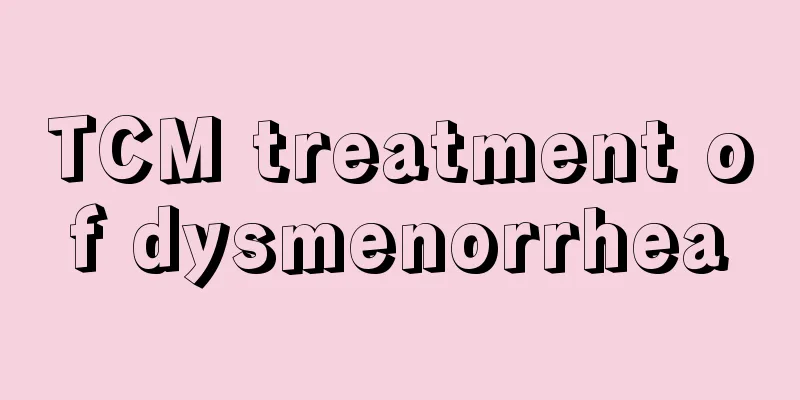TCM treatment of dysmenorrhea

|
Menstruation is a period that almost all women will experience, and along with the arrival of menstruation, the occurrence of dysmenorrhea is also the most common condition during menstruation. Generally speaking, women feel very uncomfortable during the dysmenorrhea stage. Due to excessive blood loss in the body and the occurrence of dysmenorrhea, many women cannot work normally because of dysmenorrhea. Therefore, TCM treatment of dysmenorrhea has become the most concerned issue for many women. Dysmenorrhea is the abdominal pain, swelling and other uncomfortable symptoms that women experience during their menstrual period, which causes inconvenience in life and work. Since dysmenorrhea occurs during the menstrual period, taking medicine and other methods at this stage will cause harm to the body. Therefore, traditional Chinese medicine has become the first choice for female friends to treat dysmenorrhea. Dysmenorrhea is divided into primary and secondary types. Primary dysmenorrhea is caused by no organic pelvic lesions and is mostly functional dysmenorrhea, accounting for more than 90% of dysmenorrhea. Secondary dysmenorrhea is dysmenorrhea caused by organic pelvic diseases, such as endometriosis, pelvic inflammatory disease, or cervical stenosis, intrauterine foreign bodies, etc. Only primary dysmenorrhea is discussed below. Syndrome differentiation and treatment 1. Qi stagnation and blood stasis [Symptoms] Abdominal distension and pain before or during menstruation, resistance to pressure, scanty menstrual blood, irregular menstruation, dark purple menstrual blood with clots, pain relieved under the clots; accompanied by breast distension and pain, chest tightness and discomfort; dark purple tongue or with petechiae, and stringy pulse. [Treatment method and prescription] Regulate Qi, relieve stagnation, resolve blood stasis and relieve pain. Modifications to Gexia Zhuyu Decoction. 2. Cold and blood stasis [Symptoms] Cold pain in the lower abdomen before or during menstruation, which is resistant to pressure and relieved by warmth; or delayed menstruation, scanty menstruation, dark color and clots; pale face, cold limbs, fear of cold, and lack of warmth in hands and feet; dark tongue with white coating, and deep, tight pulse. [Treatment method and prescription] Warming the meridians and dispelling cold, resolving blood stasis and relieving pain. Shaofu Zhuyu Decoction with modifications. 3. Damp-heat stasis [Symptoms] Lower abdominal pain or distension before or during menstruation, refusing to be pressed, with a burning sensation, or pain extending to the lumbar region, or lower abdominal pain at ordinary times, which worsens before menstruation; heavy menstrual flow or prolonged menstruation, dark red, thick menstrual blood or with a lot of mucus; heavy vaginal discharge, yellow in color, thick, and with a foul odor; or accompanied by fluctuating low fever, uncomfortable bowel movements, and short, yellow urine; red tongue, yellow and greasy tongue coating, and a slippery or stringy pulse. [Treatment method and prescription] Clear away heat and dampness, resolve blood stasis and relieve pain. Modifications of Qingre Tiaoxue Decoction. 4. Weak Qi and blood [Symptoms] Dull pain in the lower abdomen during or after menstruation, with discomfort when pressing or a feeling of emptiness in the lower abdomen and genitals; scanty, light-colored, thin menstruation; dull complexion, dizziness, palpitations, fatigue; pale tongue, thready and weak pulse. [Treatment method and prescription] Invigorate Qi and nourish blood, regulate menstruation and relieve pain. Modified Bazhen Yimu Decoction. 5. Liver and kidney deficiency [Symptoms] Continuous pain in the lower abdomen during or after menstruation, accompanied by lumbar and sacral pain; dark-colored menstrual blood, small amount, and thin texture; dizziness, tinnitus, gloomy complexion, forgetfulness and insomnia; pale red tongue, thin coating, and deep and fine pulse. [Treatment method and prescription] Nourish the kidney and liver and relieve pain. Modify the liver-regulating decoction. The above is an introduction to several methods of treating dysmenorrhea with traditional Chinese medicine. Generally speaking, traditional Chinese medicine treats dysmenorrhea with different conditioning methods based on different symptoms. Therefore, for women who are deeply troubled by dysmenorrhea, before choosing traditional Chinese medicine to treat dysmenorrhea, they must pay attention to choosing a method that suits their physical condition for conditioning. |
>>: TCM treatment of dysmenorrhea
Recommend
What should I do if I have wide gaps between my teeth at a young age?
Having gaps between teeth greatly affects the app...
How to remedy staying up late during menstruation
The human body has a normal routine, working duri...
When is the ovulation period if the menstruation comes on the 24th
Everyone's physical condition and living envi...
What is the reason why I am always unclean after my period?
Many girls have this feeling, that is, even after...
Can Kuntai Capsules be taken during menstruation?
The female body is very sensitive during menstrua...
What brand is the Scissors down jacket? Is there a OEM factory for the Scissors down jacket in China?
The scissor-hands down jacket was very popular in...
When is lettuce in season? Is lettuce a carbohydrate or a vegetable?
Lettuce, also known as lettuce, is one of the mos...
What is the meaning of drinking osmanthus wine during the Mid-Autumn Festival? What should you pay attention to when drinking osmanthus wine during the Mid-Autumn Festival?
Drinking osmanthus wine during the Mid-Autumn Fes...
Why do we need to improve our immunity to prevent viruses? What is the best way to improve immunity?
A normal person has a normal immune system. What ...
What should women do if they have too much armpit hair?
Nowadays, female friends like to wear sexy clothe...
What to do with female lobular hyperplasia
Nowadays, social pressure is getting greater and ...
Does thin endometrium affect pregnancy?
Will a thin endometrium affect pregnancy? Thin en...
The benefits of running on women's uterus
For most women, jogging is a good exercise for lo...
Can chronic cervical hypertrophy be cured?
Chronic cervical hypertrophy is a common gynecolo...
Medical Science | Lung Cancer Awareness Month: Protecting Respiratory Health
Medical Science | Lung Cancer Awareness Month: Pr...









